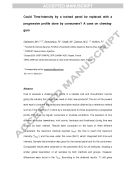Por favor, use este identificador para citar o enlazar este ítem:
https://repositorio.uca.edu.ar/handle/123456789/5425| Título: | Could time-intensity by a trained panel be replaced with a progressive profile done by consumers? A case on chewing-gum | Autor: | Galmarini, Mara Virginia Symoneaux, R. Visalli, Michel Zamora, María Clara Schlich, Pascal |
Otros colaboradores: | Universidad Católica Argentina (Buenos Aires). Facultad de Ciencias Agrarias Consejo Nacional de Investigaciones Científicas y Técnicas (Argentina) Ecole Supérieure d'Agricultures (Francia) Centre des Sciences du Goût et de l’Alimentation - INRA (Francia) |
Palabras clave: | GOMA DE MASCAR; CONSUMIDORES; PRUEBAS | Fecha de publicación: | 2015 | Cita: | Galmarini, M.V., Symoneaux, R., Visalli, M., Zamora, M.C. y P. Schilich. 2015. Could time-intensity by a trained panel be replaced with a progressive profile done by consumers? : a case on chewing-gum [en línea]. Postprint del artículo publicado en Food Quality and Preference. 48, 1ra. parte. Disponible en: https://repositorio.uca.edu.ar/handle/123456789/5425 | Resumen: | Abstract: How to evaluate a chewing-gum profile in a reliable cost and time-efficient manner giving the industry the insight they need on their new products? The aim of the present work was to compare the temporary descriptive results obtained by a reference method such as Time-Intensity (T-I) done by a trained panel to those acquired by a progressive profile (PP) done by regular consumers in in-home conditions. The evolution of four different attributes (sweetness, mint aroma, hardness and freshness) during time was studied by each method. Results were compared on the basis of three different parameters: the maximum intensity reached (Imax), the time to reach this maximum intensity (TImax,); and the area under the curve (AUC), which integrated both time and intensity. Sample discrimination was good for the trained panel and for the consumers. Comparable results were obtained for the parameter AUC for all attributes, showing a similar global description of all samples by both methods and groups. However, differences were found in the TImax. According to the obtained results, T-I still gives more detailed information and should not be replaced when small changes are studied. However, if looking to validate the sensory description of a different new prototype, the PP done by consumers in in-home conditions might be a very interesting option being more cost and time efficient | URI: | https://repositorio.uca.edu.ar/handle/123456789/5425 | Disciplina: | INGENIERIA EN ALIMENTOS | Derechos: | Acceso Abierto | Fuente: | Postprint del artículo publicado en Food Quality and Preference. 48, 1ra. parte, 2015 |
| Aparece en las colecciones: | Artículos |
Ficheros en este ítem:
| Fichero | Descripción | Tamaño | Formato | |
|---|---|---|---|---|
| could-time-intensity-trained.pdf | 139,61 kB | Adobe PDF |  Visualizar/Abrir |
Visualizaciones de página(s)
163
comprobado en 27-abr-2024
Descarga(s)
204
comprobado en 27-abr-2024
Google ScholarTM
Ver en Google Scholar
Este ítem está sujeto a una Licencia Creative Commons

